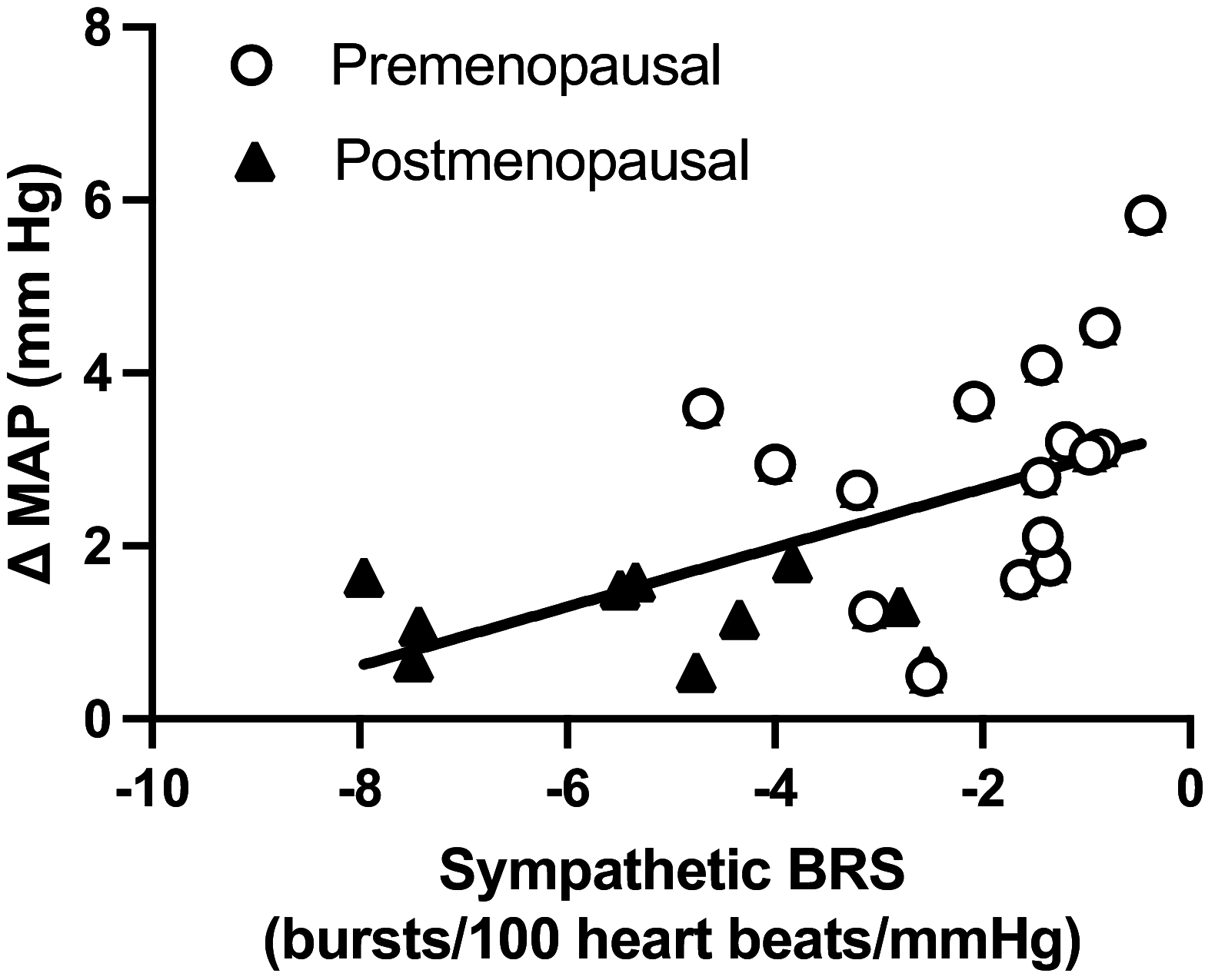Sympathetic baroreflex sensitivity is enhanced in postmenopausal women
- PMID: 38961825
- PMCID: PMC11424174
- DOI: 10.1152/japplphysiol.00833.2023
Sympathetic baroreflex sensitivity is enhanced in postmenopausal women
Abstract
The sympathetic nervous system is critical for regulating blood pressure (BP) via the arterial baroreflex and sympathetic transduction in the peripheral vasculature. These mechanisms interact, and both may be altered with aging and impacted by menopause. Although age-related decreases in sympathetic transduction have been demonstrated in women, it remains unclear whether sympathetic baroreflex sensitivity (BRS) is impaired in postmenopausal women (POST). We tested the hypothesis that sympathetic BRS would be enhanced in POST compared with premenopausal women (PRE). We examined beat-by-beat BP and muscle sympathetic nerve activity (MSNA) in 19 PRE (22 ± 2 yr, 22 ± 3 kg/m2) and 12 POST (57 ± 5 yr, 24 ± 2 kg/m2) during 10 min of rest. Spontaneous sympathetic BRS was quantified as the slope of a linear regression between MSNA burst incidence and diastolic BP. Sympathetic transduction to mean arterial pressure (MAP) for the 10 cardiac cycles following spontaneous MSNA bursts was assessed via signal averaging method. Resting MAP was similar (PRE: 82 ± 8 vs. POST: 85 ± 8 mmHg, P = 0.43), whereas resting MSNA was elevated in POST (PRE: 10 ± 6 vs. POST: 45 ± 16 bursts/100 heart beats, P < 0.0001). Spontaneous sympathetic BRS was enhanced in POST (PRE: -2.0 ± 1.2 vs. POST: -5.2 ± 1.9 bursts/beat/mmHg, P < 0.0005). Sympathetic transduction to MAP was attenuated in POST (time: P < 0.001, group: P < 0.001, interaction: P < 0.01). These data suggest that sympathetic BRS may be enhanced in POST. Consistent with recent hypotheses, enhanced sensitivity of the arterial baroreflex's neural arc may signify a compensatory response to reduced efficiency of the peripheral arterial baroreflex arc (i.e., sympathetic transduction) to preserve BP buffering capacity.NEW & NOTEWORTHY Studies examining sympathetic baroreflex function with aging remain equivocal, with some studies showing an increase, decrease, or no change in sympathetic baroreflex sensitivity (BRS) in older adults compared with younger adults. With aging, women experience unique physiological changes due to menopause that influence autonomic function. For the first time, we show that postmenopausal women exhibit a greater sympathetic BRS compared with young premenopausal women.
Keywords: arterial baroreflex; menopause; muscle sympathetic nerve activity; sympathetic transduction.
Conflict of interest statement
J.L.G. and M.M.W. are paid consultants for Orchestra Biomed. None of the other authors has any conflicts of interest, financial or otherwise, to disclose.
Figures





Similar articles
-
The effects of limb suction during arterial occlusion on arterial baroreflex in humans.Am J Physiol Heart Circ Physiol. 2025 Aug 1;329(2):H450-H456. doi: 10.1152/ajpheart.00365.2025. Epub 2025 Jul 14. Am J Physiol Heart Circ Physiol. 2025. PMID: 40657785 Free PMC article.
-
Respiratory modulation of sympathetic transduction to blood pressure in health and type 2 diabetes.J Physiol. 2024 Aug;602(16):3909-3927. doi: 10.1113/JP286627. Epub 2024 Jul 29. J Physiol. 2024. PMID: 39073892 Free PMC article.
-
Sympathetic neural and cardiovascular responsiveness to involuntary stress-induced crying.J Appl Physiol (1985). 2025 Aug 1;139(2):334-340. doi: 10.1152/japplphysiol.00419.2025. Epub 2025 Jul 7. J Appl Physiol (1985). 2025. PMID: 40623048
-
The Black Book of Psychotropic Dosing and Monitoring.Psychopharmacol Bull. 2024 Jul 8;54(3):8-59. Psychopharmacol Bull. 2024. PMID: 38993656 Free PMC article. Review.
-
Effects of a gluten-reduced or gluten-free diet for the primary prevention of cardiovascular disease.Cochrane Database Syst Rev. 2022 Feb 24;2(2):CD013556. doi: 10.1002/14651858.CD013556.pub2. Cochrane Database Syst Rev. 2022. PMID: 35199850 Free PMC article.
Cited by
-
Autonomic control of blood pressure in women: The roles of hypertension and aging.Auton Neurosci. 2025 Aug;260:103274. doi: 10.1016/j.autneu.2025.103274. Epub 2025 Mar 29. Auton Neurosci. 2025. PMID: 40188759 Review.
-
Menopause and its effects on autonomic regulation of blood pressure: Insights and perspectives.Auton Neurosci. 2025 Aug;260:103295. doi: 10.1016/j.autneu.2025.103295. Epub 2025 May 29. Auton Neurosci. 2025. PMID: 40460599 Review.
References
-
- Matsukawa T, Sugiyama Y, Iwase S, Mano T. Effects of aging on the arterial baroreflex control of muscle sympathetic nerve activity in healthy subjects. Environ Med 38: 81–84, 1994. - PubMed
MeSH terms
Grants and funding
LinkOut - more resources
Full Text Sources

